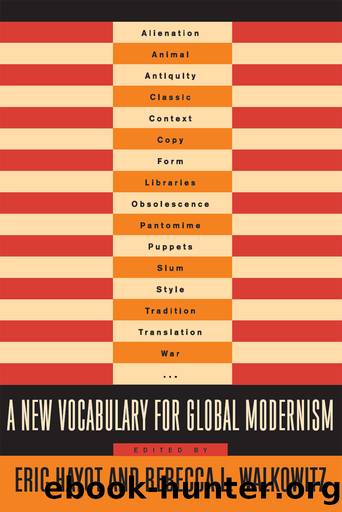A New Vocabulary for Global Modernism by Eric Hayot

Author:Eric Hayot [Hayot, Eric]
Language: eng
Format: epub
Tags: hayo16520, LIT006000, LITERARY CRITICISM / Semiotics & Theory, LIT012000, LITERARY CRITICISM / Reference
Publisher: Columbia University Press
Published: 2016-06-14T16:00:00+00:00
FIGURE 10.1 Joseph Cornell, Hotel Eden.
Source: © The Joseph and Robert Cornell Memorial Foundation / Licensed by VAGA, New York, NY.
Or put another way, Gibson conceives an AI that didn’t just manage to become sentient but to become Walter Benjamin. Like the figures about whom Benjamin writes in his essay on “Surrealism”—and, it bears mention, influences on Cornell—we see an artist who “can boast an extraordinary discovery” insofar as they “perceive the revolutionary energies that appear in the ‘outmoded.’”12 Benjamin’s writings represent modernism’s most intensive and exhaustive encounter with obsolescence, which informs not only his elaborate archaeologies of nineteenth-century modernity in The Arcades Project but also his essays on storytelling, mimesis, and “The Work of Art in the Age of Its Technological Reproducibility,” as well as the project that became The Origin of German Tragic Drama, where he is everywhere concerned with the “antique qualities of the baroque” that make it so uncannily contemporary.13 Gibson even echoes Benjamin on aura—“the unique phenomenon of distance”—in the way that these belated Cornell boxes provide for an “evocation of impossible distances” that has little to do with the hundreds of miles they may have already traveled down from orbit over Earth. In her wonderful account of “digital rubbish,” Gabrys borrows from Benjamin a methodology she links to his singular practice of “natural history” to reflect on “the fossilized commodities in the obsolete arcades of [Paris]”; here he found in objects variously “decaying” or “outmoded” what she terms “concrete facts about past cultural imaginings.”14 Gabrys herself is interested in the sorts of technological commodities that Gibson and other cyberpunk writers have long traded on, and by seeing the way that their future obsolescence gets projected onto even the latest gadgets, she helps us track the legacy of the modernist aesthetic I have been exploring here. “Obsolete objects,” Gabrys notes, evoked for Benjamin “a kind of prehistory when they fell out of circulation, at which time they could be examined as resonant material residues . . . of economic practices.” More importantly, Benjamin’s attention to obsolescence, in all its many modern forms, tried to slow down or perhaps more radically disrupt the very notion of what “progress” under capitalism really looks like in order “to demonstrate the contingency and transience of commodity worlds.” Or as Joel Burgess puts it, the modernist fetish for obsolescence, despite the ahistorical nostalgia it may risk, can generate “a series of relations between past and present as a function of the aura of datedness that its objects produce.”15 Obsolescence seems to work for modernism even when the point is that it doesn’t.
We can see this in a contemporary project that very much has modernism in its retrospective view. Produced in 2011 by Jung von Matt, a Hamburg-based digital ad agency, “The Museum of Obsolete Objects” (figure 10.2) was part of YouTube’s “Brand Channel” initiative, which allowed “marketers to create a bespoke interface, customizing the look and feel of their presence on the site” in order to “provide the opportunity to create truly persistent relationships” with customers online.
Download
This site does not store any files on its server. We only index and link to content provided by other sites. Please contact the content providers to delete copyright contents if any and email us, we'll remove relevant links or contents immediately.
| Ancient & Classical | Arthurian Romance |
| Beat Generation | Feminist |
| Gothic & Romantic | LGBT |
| Medieval | Modern |
| Modernism | Postmodernism |
| Renaissance | Shakespeare |
| Surrealism | Victorian |
4 3 2 1: A Novel by Paul Auster(11052)
The handmaid's tale by Margaret Atwood(6856)
Giovanni's Room by James Baldwin(5879)
Big Magic: Creative Living Beyond Fear by Elizabeth Gilbert(4723)
Asking the Right Questions: A Guide to Critical Thinking by M. Neil Browne & Stuart M. Keeley(4576)
On Writing A Memoir of the Craft by Stephen King(4214)
Ego Is the Enemy by Ryan Holiday(3991)
Ken Follett - World without end by Ken Follett(3973)
The Body: A Guide for Occupants by Bill Bryson(3802)
Bluets by Maggie Nelson(3711)
Adulting by Kelly Williams Brown(3671)
Guilty Pleasures by Laurell K Hamilton(3587)
Eat That Frog! by Brian Tracy(3514)
White Noise - A Novel by Don DeLillo(3436)
The Poetry of Pablo Neruda by Pablo Neruda(3367)
Alive: The Story of the Andes Survivors by Piers Paul Read(3312)
The Bookshop by Penelope Fitzgerald(3229)
The Book of Joy by Dalai Lama(3218)
Fingerprints of the Gods by Graham Hancock(3214)
